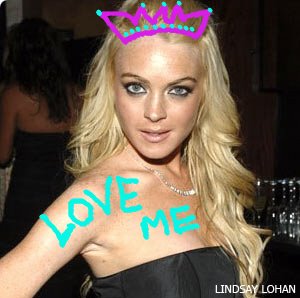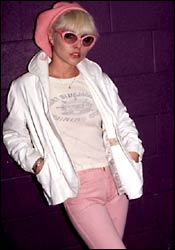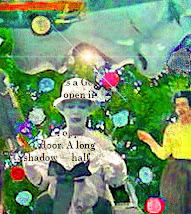 Clara Bow (left), original "It" Girl
Clara Bow (left), original "It" Girl and Lindsay Lohan (below), "It" Girl, 2005

In case you haven't heard, former "mean girl" Lindsay Lohan was voted (by what we are sure if a very scientifically accurate voting system ) Hollywood's "It" girl at the VH1 Big in '05 awards. The term "it girl" suggests that a girl is "it" and has "it." But what, pray tell, is "it"?
According to Wikipedia:
An It girl is a young woman famed for her good looks, but in recent years has come to describe a new up-and-coming young starlet who has recently broken into mainstream cinema. The term was coined after Clara Bow made the film It in 1927, which was a vehicle for her sex-appeal. Consequently, Bow was dubbed the "It girl", "It" being a euphemism for sex-appeal.
The pronoun "it" is most often used to refer to a previously mentioned, non-human object. Yet in this case "it" is meant to connotate a sexually desirable woman. Interestingly, the word "girl" describes a female who has yet to come into her sexual maturity. In this sense, the term "It girl" works to suggest immaturity, pliability, and submission. The term "it" also suggests the possession of qualities that are otherwise mysterious or ineffable (akin to what American Idol judges refer to as "star quality"). Women have frequently been associated with the mysterious -- especially when it comes to their sexuality -- and this seems to be echoed in the term's lack of specificity. Moreover, the label "It girl," in it's elision of distinctive characteristics, also suggests an object of temporary attraction. Sooner or later the term "it" migrates to someone else. "It"'s lexical function is to suggest interchangeability.
But "it" has an obscene underbelly too, and is often used to stand in for something that otherwise "cannot be named." Kids talk about doing "it," and the doubly disturbing term "hitting it," with its creepy implication of both violence and objectification, seems to be gaining popularity. And the word "it" is also used to describe the terror without a name in Stephen King's novel It. Perhaps most disturbing are the of reports of victims of abuse being referred to as "it" by their abusers (i.e. the serial killer in Silence of the Lambs refers to his victims as "it;" and then there's that book A Child called "It"). "It" is also used to suggest gender ambiguity.
Interestingly, the first "it"girls were often presented as being entirely unique; they were perceived to be both an embodiment of everything that was appealing and desirable at a particular time, and also a portent of what was to come. Today's "it" girls seem more akin to a chain of paper dolls, suggesting a shift from the unique towards the generic.
Meet America's newest obsession: Hollywood It Girls. Smoking hot and barely legal, they live in multi-million dollar pads, zip around town in the coolest cars and date Hollywood boy-toys all the other girls would kill for- all while carrying around their pooches in thousand-dollar Louis Vuitton purses. And while these young starlets cross every velvet rope in town, nobody dares to cross them.
It's unsettling that one of the terms used to describe contemporary "It" girls is "barely legal." This is, after all, also the name of a porn magazine. Beyond the obvious narrative of class aspiration, their narrative appears also to be one of power -- they can cross any velvet rope and take any lover they desire. And yet the narrative of the contemporary "It" girl hardly seems to be one of empowerment. Consider this year nominees for the Big in 'O5 awards: L.Lo, Nicole, Paris, and Kritin Cavallari. At first glance, the only "it" these girls seem to share is a penchant for Smirnoff ice and an inability to gauge the proper sunglass size.
Contemporary "it" girls appear to dress and act the same; they seem to represent a sort of "dollification" of Hollywood. This seems eerily literal when one considers how many celebs also go under the knife in order to be more marketable. The identical fake tan, fake boobs, and fake hair of many "it" girls is both troubling and puzzling (see this amusingly cynical take on what it means to be an "it" girl). And more and more dolls are meant to be Hollywood it girls (see My Scene and Bratz). And those dolls are nasty.
There have been groups of sort of alternative "it" girls: Nico, Edie Sedgwick, Marianne Faithful, and Debbie Harry. Interestingly, women like Nico and Eddie Sedgwick were part of Andy Warhol's circle -- a scene that originally emerged as a sort of parody or facsimile of Hollywood. These types of "It" girls may also be related to the women in the films of Alfred Hitchcock and David Lynch. And to ingenues and femme fatales and vamps.
Besides being rich, "It" girls are also conspicuously white. Although Eartha Kitt and Halle Berry and Beyonce could be considered "it" girls, there still aren't enough roles for black women and minorities in Hollywood and minority women are still (sadly) less likely to appear on the cover of magazines.
And, perhaps the biggest question, why "It" girls and not "It" boys? More on that in a future post.
But for now, what do you think of the term "it" girl? Discuss.

Debbie Harry, "it" girl
Related links:
Hollywood's shrinking "it" girls (splendora blog)
The It Girl (fiction)
"it" girls looking for love
The original "It" girl (Bint Magazine)
and when you google "it girl," half the results are about IT, which is often depicted as a big sausage party:
Why is IT all male?
Recruiting the new IT girls (BBC)
More IT Girls (BBC)
Contemporary "it" girls appear to dress and act the same; they seem to represent a sort of "dollification" of Hollywood. This seems eerily literal when one considers how many celebs also go under the knife in order to be more marketable. The identical fake tan, fake boobs, and fake hair of many "it" girls is both troubling and puzzling (see this amusingly cynical take on what it means to be an "it" girl). And more and more dolls are meant to be Hollywood it girls (see My Scene and Bratz). And those dolls are nasty.
There have been groups of sort of alternative "it" girls: Nico, Edie Sedgwick, Marianne Faithful, and Debbie Harry. Interestingly, women like Nico and Eddie Sedgwick were part of Andy Warhol's circle -- a scene that originally emerged as a sort of parody or facsimile of Hollywood. These types of "It" girls may also be related to the women in the films of Alfred Hitchcock and David Lynch. And to ingenues and femme fatales and vamps.
Besides being rich, "It" girls are also conspicuously white. Although Eartha Kitt and Halle Berry and Beyonce could be considered "it" girls, there still aren't enough roles for black women and minorities in Hollywood and minority women are still (sadly) less likely to appear on the cover of magazines.
And, perhaps the biggest question, why "It" girls and not "It" boys? More on that in a future post.
But for now, what do you think of the term "it" girl? Discuss.

Debbie Harry, "it" girl
Related links:
Hollywood's shrinking "it" girls (splendora blog)
The It Girl (fiction)
"it" girls looking for love
The original "It" girl (Bint Magazine)
and when you google "it girl," half the results are about IT, which is often depicted as a big sausage party:
Why is IT all male?
Recruiting the new IT girls (BBC)
More IT Girls (BBC)



No comments:
Post a Comment